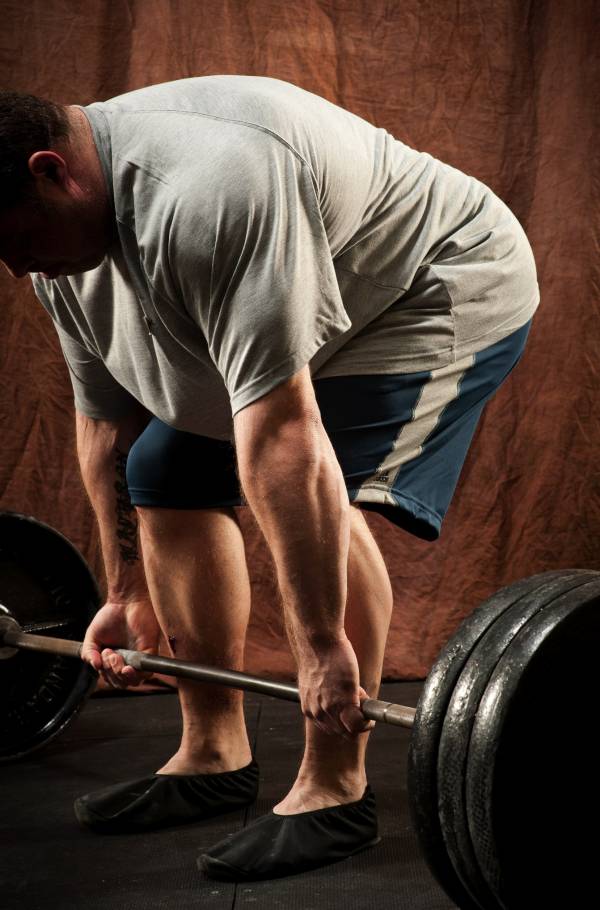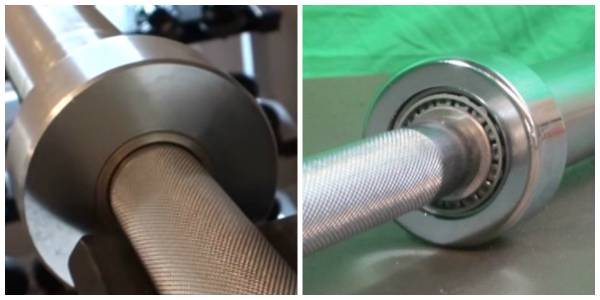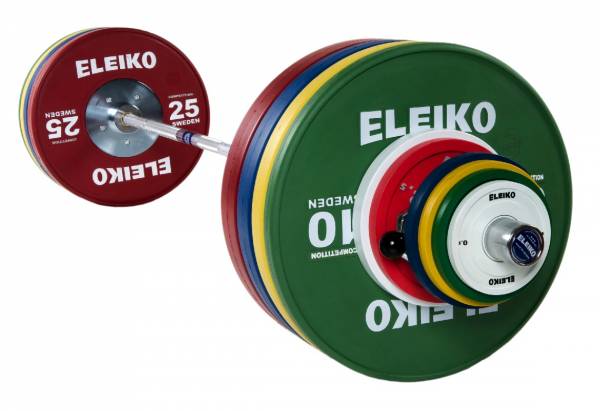Picking a barbell can be difficult. There are many options. This article will guide you through the decision-making process so you come out with the best bar for your needs and goals.
Barbell Basics
Type of Bar
Powerlifting bars typically have a more aggressive knurling to assist with grip. The markings for the grip are a bit wider than the markings on Olympic weightlifting bars. Generally, powerlifting bars are also stiffer than Olympic bars, though there are some specialized deadlifting bars that have more bend and are longer. This is because the more the bar bends, the more the end plates are left on the ground.
Westside Bar from Rogue
Olympic bars have less aggressive knurling. They provide enough grip, but not enough to tear your hands in the transition of movements. These bars are known for having more whip or bend (see below for details). Olympic bars also have collars that spin. As the bar is moving up through the lift, the spin goes with the momentum of the weight to assist the lifter.
Hybrid bars attempt to take the best of each type of bar. They often have two set-up markings to line up with Olympic lifting and powerlifting standards. They might have some whip and some spin depending on the bar. These bars are useful for gyms that do both types of lifting in one training session or anyone needing to be economical.
Example of a hybrid style bar – the Rogue Bar 2.0
Size of Bar
The diameter and length of barbells are different and are often denoted by men’s and women’s size.

Specifics
Yield Strength
Yield strength gets at the amount of weight that can be put on a bar for it to bend and then not bend back to being straight. In general, we want bars to have some bend to them. As mentioned above, greater bend in a deadlift leads to the end plates staying on the floor for longer time. But we do not want that bend to remain.

Yield strength deals with the amount of weight it would take to permanently bend the bar. This test is considered a static test, as more and more weight is simply added to the ends. But when lifting weights, you also apply dynamic force (different force at different parts of the movement), so a different test might be more useful.
Tensile Strength
Tensile strength is tested dynamically. It is rated in pounds per square inch (PSI), which is the amount of weight needed to pull the bar apart. High-end Olympic bars by Eleiko or Ivanko use steel rated at over 200,000 PSI. Anything over 180,000 will fit most everyone.
Whip
The whip of the bar is the bounce that occurs as the lifter stops moving and the momentum of the bar continues. Whip is useful in the transition between a clean and a jerk. An experienced lifter bounces the bar off the chest and uses the momentum of the bend coming upward to help propel the bar into the jerk position. For an example watch at around 1:26 of the following video:
Whip is difficult to measure quantitatively. It depends on the diameter of the barbell (skinnier bars have more whip) and the type of steel. You might have to rely on reviews or online videos for subjective measures of whip.
Sleeve
Inside the sleeve of the bar are the mechanics that determine how much spin the bar will have. Bushings are solid materials that have low friction (brass is commonly used). Bearings are small balls or needles within a sleeve that roll. Bearings generally allow for faster spin, but they are often more expensive.

LEFT: Bushing; RIGHT: Bearings
If you are in the market for an olympic barbell spin will be one of the most important factors. If you can’t test the bars in person, there are many online videos showing the different spins of barbells.
Finish
Bare steel bars have no finish on them and are prone to rusting, but have a nice grip. They need a good deal of maintenance. Zinc finishes provide more protection and comes in black or bright finishes.
Chrome provides the most protection and is usually the most expensive. It comes in satin or polished options. Chrome can also feel a bit more slippery depending on the finish, but the top of the line bars often have a chrome finish and still have great grip.
Center Knurling
The center knurl helps keep the bar on the back during back squats. It will be seen on powerlifting bars. On many Olympic bars there is not center knurling and it might be a different texture than the outer knurling.

Texas Squat Bar from Elite FTS
Summary
Hopefully I’ve clarified some of the options for barbells. Different bars are suited for different tasks. Trying to find the bar that fits most of your needs is important. We will do a comparison of different barbells (based on specialty) in the future. (Manufacturers, please contact us to include your barbell in a review).
You’ll Also Enjoy:
- How Barbell Knurling Differs and How This Impacts Different Lifters
- An Argument Against the Barbell
- DIY Beast Mode Gear: How to Build Your Own Barbell
- What’s New On Breaking Muscle Today
Photo 3 courtesy of Dragon Door.








